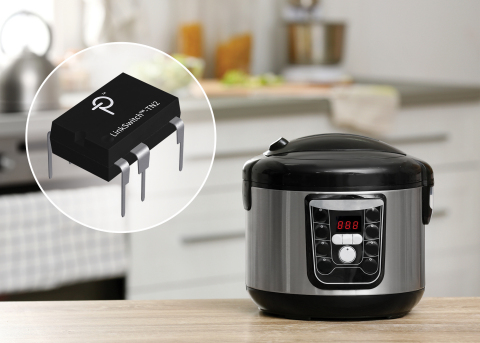Uprated LinkSwitch AC-DC Converter ICs From Power Integrations Increase Available Current by 60%
Power Integrations (Nasdaq: POWI), the leader in high-voltage integrated circuits for energy-efficient power conversion, today announced a new member of its acclaimed LinkSwitch™-TN2 AC-DC converter family. The new LNK3207 ICs facilitate higher-power offline buck converter designs for appliances and industrial applications by increasing the available output current from 360 mA to 575 mA, while also reducing BOM count.

Power Integrations' LinkSwitch-TN2 ICs increase output current from 360 mA to 575 mA & target mass-market appliances such as washers, dryers, coffee makers and more. Design engineers can easily upgrade existing designs while reducing BOM count. (Photo: Power Integrations)
Silvestro Fimiani, product marketing manager at Power Integrations said: “These new LinkSwitch-TN2 ICs are pin-to-pin compatible with previous generations, making it simple for customers to upgrade to higher-power designs. A high-current buck converter can be created using a minimal number of easily available components while saving at least one diode over previous solutions.”
The LNK3207 AC-DC converter ICs increase the available current by
The new LinkSwitch-TN2 ICs target mass-market appliances such as washers, dryers and coffee makers, which benefit from their design simplicity. They are also suitable for sensor-based devices that require low power such as home security cameras and smart thermostats, as well as metering and IoT installations. Devices are available in three packages, PDIP-8C, SMD-8C and SO-8C, for design flexibility. The SMD-8C package is ideal for high-temperature ambient 85/105 °C applications.
Availability & Resources
LNK3207 AC-DC converter ICs are priced at
About Power Integrations
Power Integrations, Inc. is a leading innovator in semiconductor technologies for high-voltage power conversion. The company’s products are key building blocks in the clean-power ecosystem, enabling the generation of renewable energy as well as the efficient transmission and consumption of power in applications ranging from milliwatts to megawatts. For more information, please visit www.power.com.
View source version on businesswire.com: https://www.businesswire.com/news/home/20210323005454/en/







